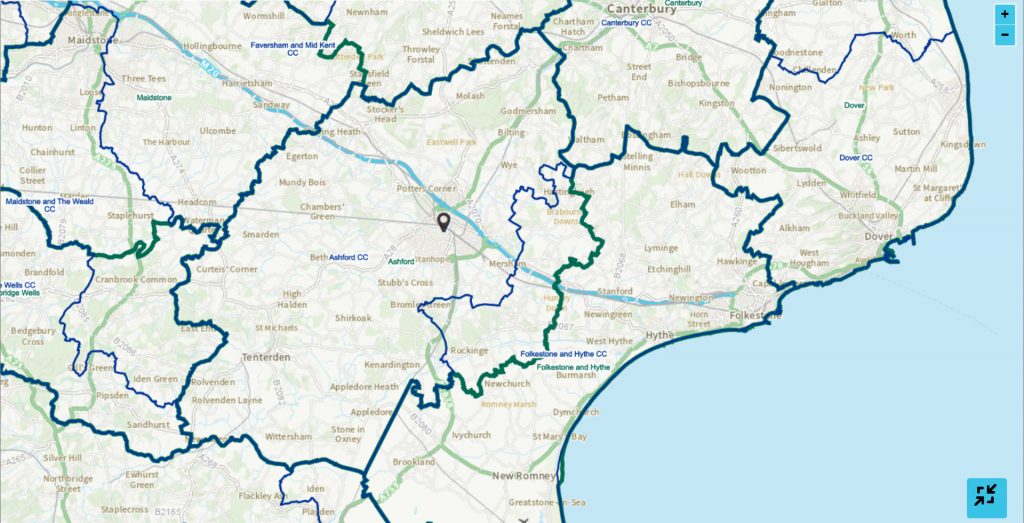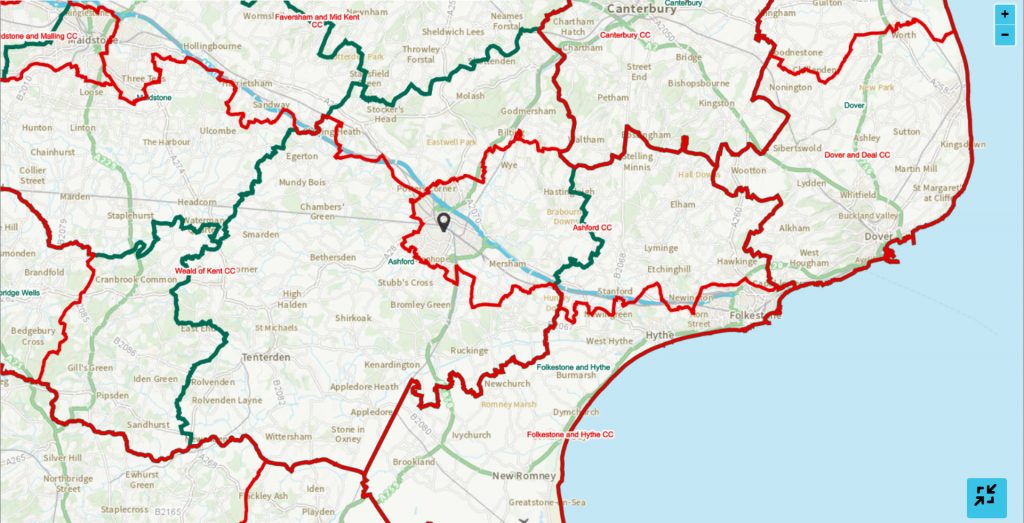The Ashford Parliamentary Constituency will be separated from the majority of the Borough under Initial Proposals put forward by the Boundary Commission for England.
The Boundary Commission for England (BCE) is currently conducting a review of parliamentary constituency boundaries on the basis of rules most recently updated by Parliament in 2020. These latest rules retain 650 constituencies for the UK Parliament as a whole, and require constituencies that are proposed or recommended to comply with strict parameters, in particular as far as the number of electors in each constituency is concerned.
The BCE has published its ‘Initial Proposals’, which will see South Ashford in the same Constituency as Hawkinge and Elham but different to that of Great Chart and Kingsnorth.

The existing Ashford Parliamentary Constituency boundary, shown as a narrow blue line, follows the Borough boundary, thicker green line, other than an area to the east, which includes Ruckinge, Aldington and Brabourne, and is part of the Folkestone and Hythe Constituency.

The Initial Proposals published by BCE will see the Borough split across three constituencies, with boundaries shown red against the green Borough boundaries.
- Ashford urban area, including the Town Centre, Stanhope and Singleton will be in a constituency which extends eastward to Hawkinge and Wingmore.
- The south and west of the Borough, including Aldington, Ham Street, Wittersham, Tenterden, Kingsnorth and Great Chart will be in a new Weald of Kent Constituency, which stretches as far as the outskirts of Maidstone and includes Boughton Monchelsea, Loose and Nettlestead.
- The northern part of the Borough including Chilham, Bilting, Boughton Lees, Sandyhurst Lane, Westwell and Charing will become part of the Faversham and Mid-Kent Constituency with with villages as far west and north as Bredgar, Radfield and Conyer.
The primary criteria for the new boundaries is that apart from five specified exceptions – every constituency recommended must have an electorate (as at 2 March 2020) that is no less than 95% and no more than 105% of the ‘UK electoral quota’. The UK electoral quota for the 2023 Review is, to the nearest whole number, 73,393.
Accordingly, every recommended constituency (except the five ‘protected’ constituencies) must have an electorate as at 2 March 2020 that is no smaller than 69,724 and no larger than 77,062.
The BCE may take into account in establishing a new map of constituencies for the 2023 Review:
- special geographical considerations, including in particular the size, shape and accessibility of a constituency;
- local government boundaries as they existed (or were in prospect) on 1 December 2020 (see paragraph 16 above);
- boundaries of existing constituencies;
- any local ties that would be broken by changes in constituencies; and
- the inconveniences attendant on such changes.
BCE have published a guide to the Review:
boundarycommissionforengland.independent.gov.uk/2023-review/guide-to-the-2023-review-of-parliamentary-constituencies/
You can comment on the proposals on the BCE consultation website www.bcereviews.org.uk/.
Comments must be made by Tuesday 2nd August 2021.

